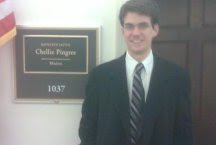The work day in D.C. starts far earlier than what I call the triple-S back at school (Sleepy Student Stumble). Back at school, it is quite possible to roll out of bed at 9 or later every morning of the week. Here, it’s necessary to boot up a bit earlier, closer to 7 am.
I’ve completely given up trying to predict rush hour patterns on the Metro. The first few weeks I thought I saw a pattern: packed on Monday, Tuesday and Wednesday. Thursday and Friday, the crush of people seemed to taper off a bit. But since the snowstorm, the seething mass of well-dressed commuters is about as predictable as New England weather systems. Or New Englanders in general, for that matter.
After getting motion sickness from a Metro system which refuses to use their Automatic Train Operator mode (in a faulty attempt to make riders feel more safe after last June’s Red Line collision), I arrive at my stop, where I make my way topside, down K Street (home of the American lobbying empire), to KSCW, Inc.
Intern mornings are spent summarizing relevant and important news items for our clients. These summaries are carefully edited, which is a great learning process for me, as someone interested in writing. Once these summaries have cleared our outboxes, we turn our attention to various special projects which firm partners or associates assign to us.
These projects usually involve a great deal of in-depth research. Interns at this level are generally expected to know how to do that research, how to pull out only the most relevant data, summarize that and present it in an appropriate and easily accessible format. I wouldn’t be surprised if over 50% of what I learn and read during the day is never really used, but that’s my job: to act as a human filter for the volumes of information made available for and by millions of users worldwide.
There are a great deal of out and about opportunities for us as well. In my work so far, I’ve been lucky enough to get to witness something I came to K Street to see: the lobbying process. Because lobbying has been so intensely focused on in the past decade or so as the boogeyman of government, I wanted to see for myself how the governing process works, from the business and advocacy angle, which is not discussed in any textbooks I know of. In fact, the best information available to the general public on lobbyists is from large media outlets, and it’s not always pretty.
What I’ve seen so far, sitting in on business lunches, strategy sessions and Capitol Hill meetings is this: lobbyists are a sophisticated class of lawyers, experts, former staffers or elected officials. They are there because they have connections and they know how to get ideas turned into law. They are hired by every group possible from every corner of the country, any coalition, association or alliance imaginable. These groups pay well because they are paying for the experts to maneuver through Washington for them and get results. While it is an atmosphere that has seen it’s fair share of corruption, I’m still hard pressed to find a better system for advocacy within our capitalist based economy.
When I've finished a day's work of research, taking notes, sitting in on strategy sessions, meetings or hearings of interest, it’s time to head home. My work for KSCW being done for the day, I turn first to any assignments from my Washington Center program or academic course. If the chance comes up, I’ll meet friends for a few drinks after work or we’ll do dinner together.
Usually once or twice a week, we’ll go to one of many, many fascinating events hosted in the city: from talks by public figures (such as Howard Dean) to cultural events (such as the Chinese New Year celebration), to Kennedy Center performances. All these night-life attractions are easy to find out about, and some of them are either free or open to the public (or sometimes both).
In general, my days are fantastic. Doing an internship, especially removed from your home school, is a delightfully refreshing taste of the real world, a world without classes whose legitimacy you question, a world where people and events run on time, a world of responsibility, independence and so much more to do.





No comments:
Post a Comment